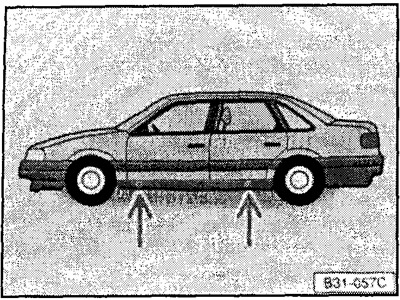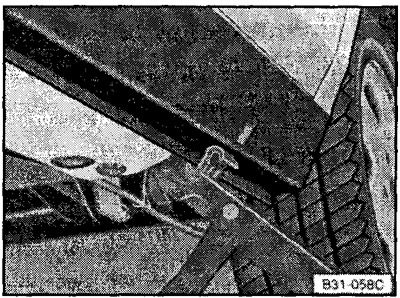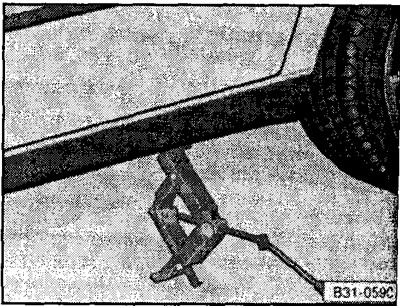
Volkswagen Passat is equipped with a compact spare tire (in some cases, some models are equipped with a regular spare wheel instead of a small one). The compact wheel not only takes up significantly less space in the trunk, but is also much lighter.
Small wheel tire pressure (4.2 atm) check regularly that the spare wheel is always ready for use. The valve is accessed through a hole in the wheel rim.
The wheel is stowed in the niche of the trunk floor (under floor covering) and secured with a wing nut.
When using a small spare wheel, please note the following:
- The small spare wheel is designed for short-term use and should be replaced with a regular wheel as soon as possible.
- After installing a small-sized spare wheel, it is necessary to check the air pressure in the tire, which should be 4.2 atm.
- Do not drive faster than 80 km/h on the spare wheel! Avoid sudden acceleration, heavy braking and sharp turns.
- The compact spare wheel is significantly smaller than a conventional spare wheel, so when it is installed, the ground clearance of the corresponding wheel is reduced by about 30 mm (the all-wheel drive car Volkswagen Passat syncro is equipped with a spare wheel that has approximately the same diameter as a regular one. This is necessary for the normal operation of the transmission of an all-wheel drive vehicle). To avoid damage to the underside of the vehicle, do not drive over large obstacles or deep potholes, or drive into overpasses or car washes.
- Some Volkswagen Passat models are equipped with a compact spare wheel designed specifically for this type of vehicle. You cannot use this wheel for another car.
- The use of snow chains on a compact spare wheel is not permitted for technical reasons.
- If the use of snow chains is necessary, you can put a small-sized wheel on the rear axle, replacing the defective front wheel with a free rear one. It is recommended to fix the chains on the wheel before installing the wheel on the car.
- The small spare wheel rim must not be fitted with conventional or winter tires.
- Never fit more than one small spare tire on a vehicle.
Wheel replacement
If the tire is flat while driving, it is necessary to take the car out of the carriageway if possible (to the side of the road). If this is not possible, it is necessary to protect yourself, passengers and the car by turning on the emergency alarm and setting the warning triangle in accordance with the requirements of the rules.
Passengers must get out of the car and stay in a safe place off the road during repairs (e.g. on the sidelines).
Put the car on the handbrake. In addition, block the wheel located diagonally from the one being replaced by placing stones or other similar objects under it on both sides.
Remove the tools and spare wheel from the trunk.

Remove wheel covers. To do this, use a special bracket (puller), supplied with the tool kit (see fig.). Sometimes alloy wheel rims are fitted with caps that can be pry off with the flat end of a screwdriver.

Slide the wheel wrench all the way onto the wheel bolt as shown in fig. ВЗ1-056С, and turn the bolt counterclockwise. Keep the key in this case as close as possible to the end of the lever.
If the bolts are tight, you can gently push the end of the key with your foot while holding on to the car and being careful.
Loosen all wheel bolts by turning them about one turn.

Position the jack: Markings on the body sill, front and rear, indicate where the jack should be placed (in the figure shown by arrows), which are located at a distance of approximately 15 and 27 cm from the front and rear wheel arches, respectively.
Installing the jack in other places may cause damage to the vehicle.

Raise the foot of the jack by turning the handle to the level of the car.
The foot must be horizontal and rest against the threshold of the body so that when the car is raised, the jack cannot slip - see fig.
If the ground is soft, you need to put a reliable lining under the jack (board) appropriate size.

Raise the vehicle slightly by turning the handle to make sure the jack is securely installed. Rotating crank) further, raise the machine so that the defective wheel is off the ground.
Completely unscrew the already loosened wheel bolts (for this it is convenient to use a screwdriver with interchangeable nozzles, including a nozzle for wheel bolts). Place the bolts on a clean pad (wheel cap, cloth, paper).
Remove the wheel and immediately install the spare in its place. Install the wheel bolts and tighten slightly. Bolts must be clean - they must not be lubricated.
Lower the vehicle to the ground and finally tighten the bolts with the wheel wrench.
If a regular wheel is used as a spare, replace the cap.
Put the defective wheel in the trunk and secure with a wing nut.
On some models, the spare wheel well is covered with a cover and locked.
Directions
After changing a wheel, do the following:
- Be sure to check the air pressure in the tire of the installed wheel.
- At the earliest opportunity, check the tightening torque of the wheel bolts with a torque wrench - it should be approximately 110 Nm.
If, when installing the spare wheel, you notice that the wheel bolts are rusty and hard to tighten, they should be replaced before checking the tightening torque.
Until then, as a precaution, you should drive at a limited speed.
On vehicles with a small spare wheel, the defective wheel must be repaired and replaced as soon as possible.

Visitor comments